Indulge in the delightful flavors of freshly baked Naan Bread with this easy-to-follow recipe. With a soft and fluffy texture and a touch of smoky char, naan is a perfect accompaniment to your favorite curries and a delicious treat on its own.
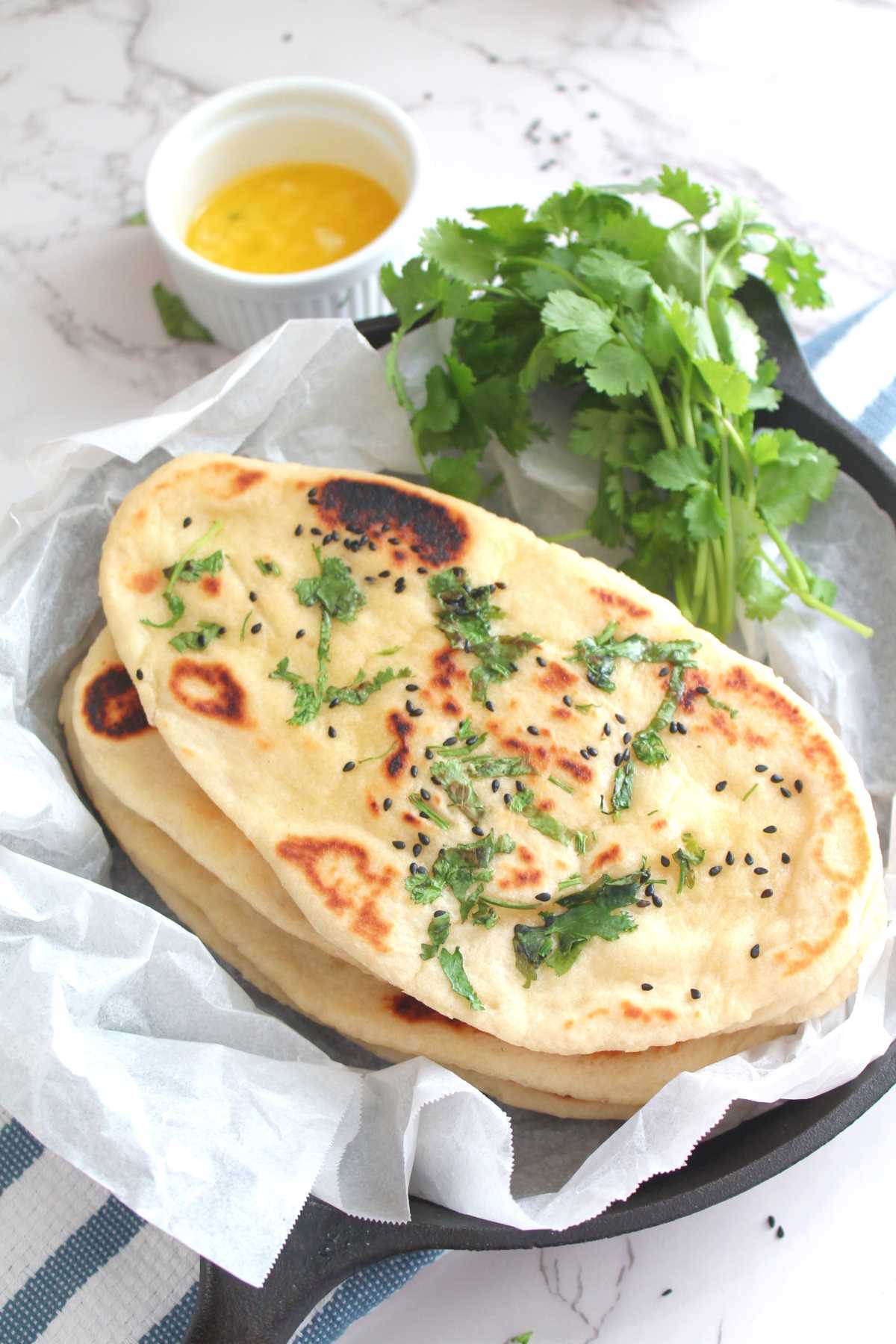
Naan Bread, one of the most popular Indian flatbreads, served in restaurants around the globe. This pillowy soft, buttery naan comes in quite a few variations - plain, stuffed, flavored. The most common ones are plain, butter, and garlic naan.
Over time, naan has evolved, and you can now find various delicious variations, such as garlic naan, cheese naan, and stuffed naan with fillings like potatoes, Paneer [Indian Cottage Cheese], or minced meat.
Traditional naan is often enjoyed as an accompaniment to various savory dishes like curries, kebabs, and tandoori meats. It can also be served with condiments like chutneys or used as a wrap for kebabs and other fillings.
I like to serve Naan bread with Indian curries such as Butter Paneer Masala, Chana Masala [Indian Chickpea Curry], Aloo Gobhi, Butter Chicken, Dal Makhani [Madras Lentils], Lamb Korma, Palak Paneer [Spinach with Indian Cottage Cheese], and so on.
Jump to:
What Is Naan?
Naan is a leavened, flatbread that is traditionally made in an open clay oven called tandoor. Leavening agents such as yeast, baking soda, or baking powder are used, to make this naan soft and fluffy.
Naan is made with flour, butter, liquid (milk, or water), leavening (yeast, yogurt, baking soda, or baking powder), salt, and sugar. The traditional way of proofing the Naan Bread dough is to let it rise at room temperature until it's doubled in volume. Then punch it down, shape it, and proof it again until almost doubled in volume. Finally, shape the naan and cook it on a Tawa (cast-iron griddle) and serve them warm with some butter.
While it is difficult to find a tandoor at home, it is usually baked in an oven, or on a Tawa (cast iron griddle) to achieve the same texture. It takes a couple of minutes to cook a perfect easy naan recipe that is crispy, slightly charred on the outside, pillowy soft, and flaky on the inside.
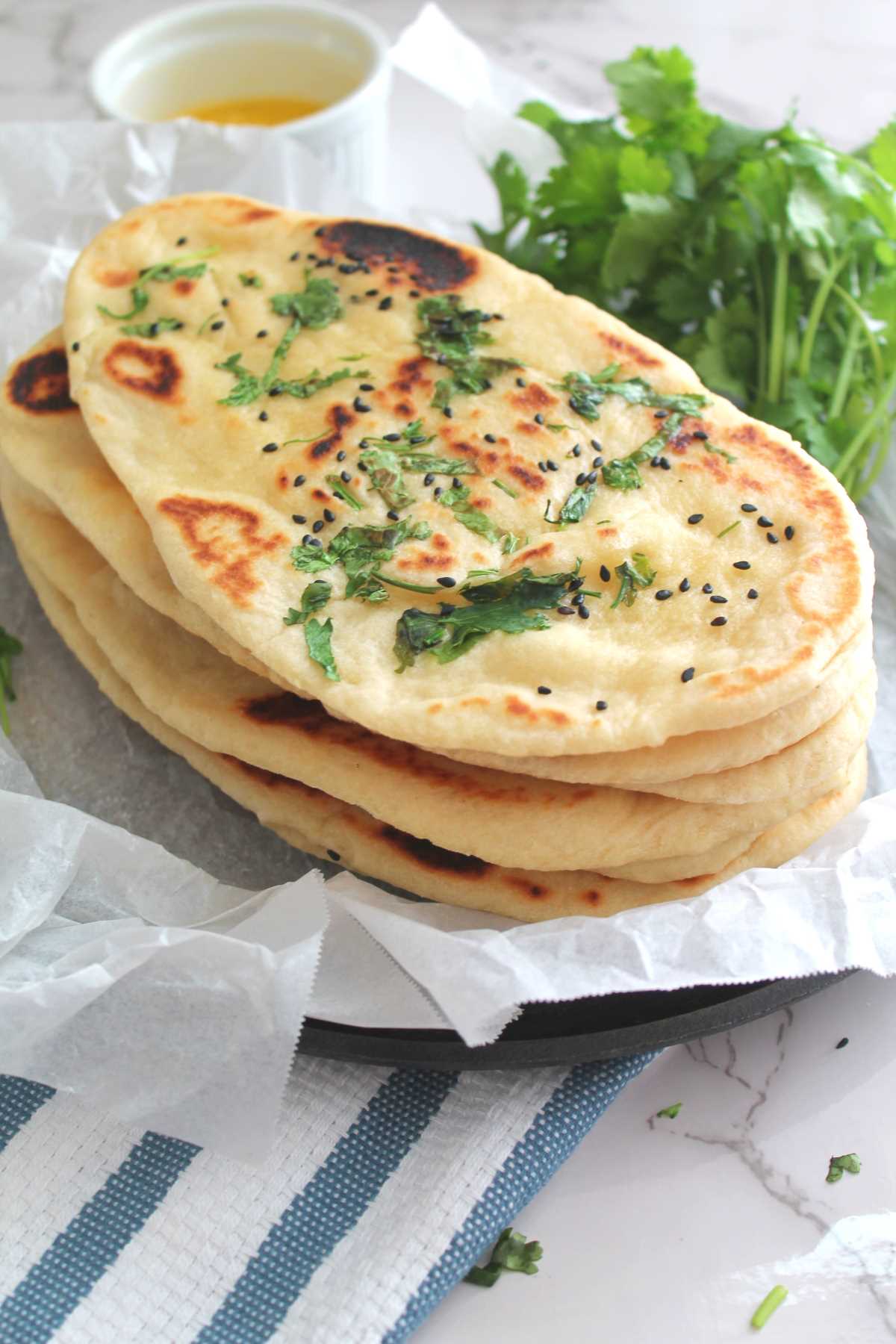
Difference Between Naan And Roti
Naan and roti, both are Indian flatbreads. Roti is an unleavened bread, which means, to make the roti dough you don't need any leavening agents such as yeast, baking soda, or baking powder. Traditional roti dough is made with simply plain whole wheat flour and some water for binding the dough. Roti is then rolled in a round shape and roasted on Tawa.
Traditional naan bread dough is made with all-purpose flour, some kind of leavening agents (yeast, baking soda, or baking powder), sugar, yogurt, milk or water, salt, and butter or oil. It is then allowed to be proofed, double in volume, and then rolled into an oval or round shape and baked in an open clay oven called tandoor.
Ingredients
Here's a brief description of the main ingredients used in this easy Naan Bread Recipe:
All-Purpose Flour: Also known as plain flour or maida, it forms the base of the naan dough, providing the necessary structure and texture.
Yeast: A leavening agent that helps the dough rise and gives naan its soft and airy texture.
Yogurt: Adds moisture, tanginess, and tenderness to the naan, contributing to its distinct flavor.
Water: Essential for hydrating the dough and activating the yeast.
Sugar: Feeds the yeast, promoting fermentation and enhancing the naan's browning during baking.
Ghee or Oil: Ghee, a clarified butter, or oil provides richness and flavor to the naan dough.
Toppings (Optional): Nigella seeds (kalonji) or sesame seeds, fresh garlic, chopped (For Garlic Naan), or a handful of fresh cilantro.
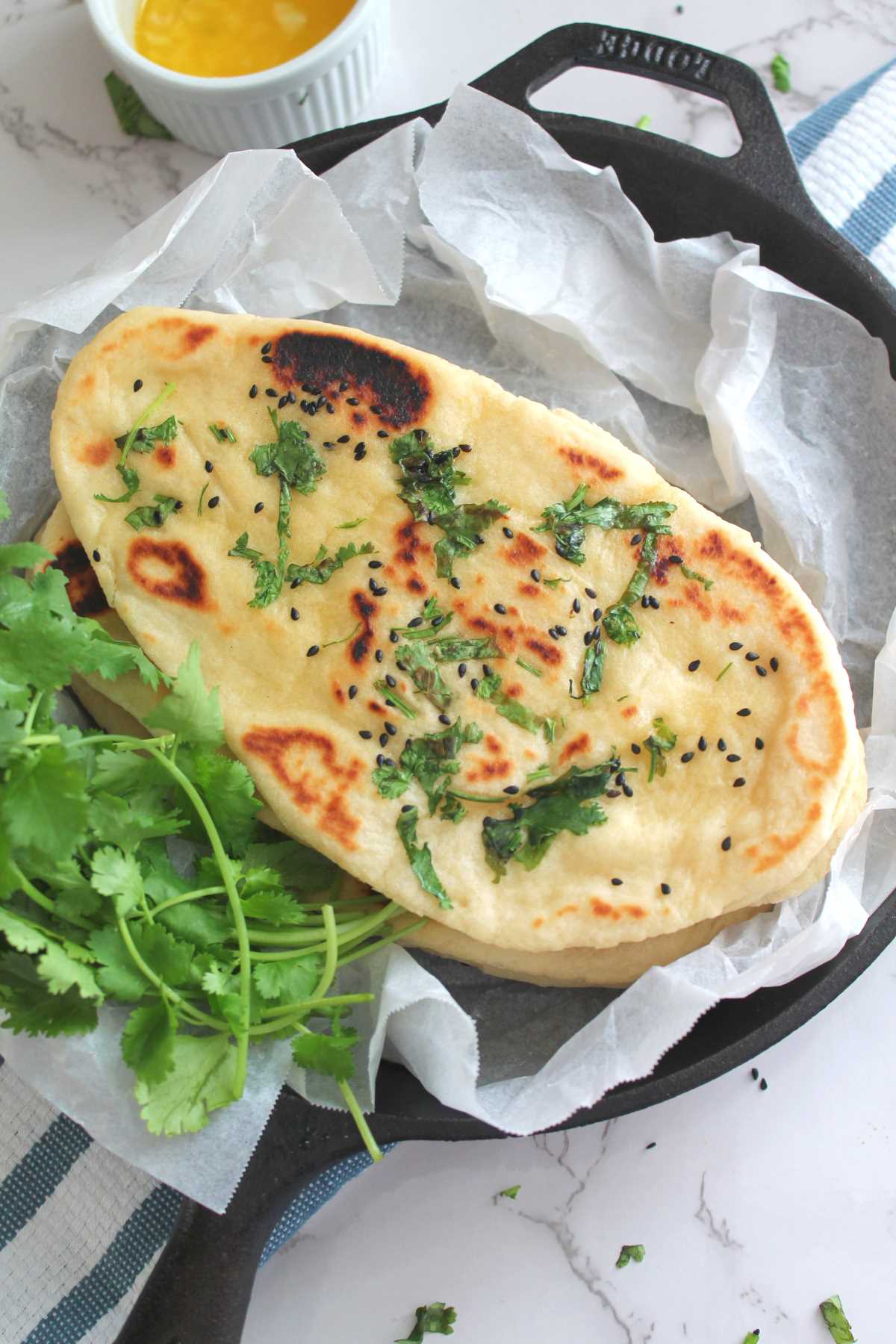
How To Make Naan Bread
Here's a step-by-step description of how to make easy naan bread recipe:
Activate the Yeast: In a small bowl, mix the warm water and sugar. Sprinkle the yeast over the water and let it sit for about 5-10 minutes until it becomes frothy. This indicates that the yeast is activated and ready to use.
Prepare the Dough: In a large mixing bowl, combine the all-purpose flour and salt. Add the activated yeast mixture, plain yogurt, and ghee (or vegetable oil). Mix all the ingredients together until they form a rough dough.
Knead the Dough: Flour a clean surface and transfer the dough onto it. Knead the dough for about 5-7 minutes until it becomes smooth, soft, and elastic. You can also use a Stand Mixer with a dough hook attachment to knead the dough.
Let the Dough Rise: Place the kneaded dough in a lightly oiled bowl and cover it with a damp cloth or plastic wrap. Let it rest in a warm, draft-free place for about 1 to 1.5 hours, or until it doubles in size. This allows the yeast to ferment the dough, making it airy and light. You can also use Instant Pot to proof the dough.
Preheat the Oven: Preheat it to the highest temperature possible, ideally with a pizza stone or an upside-down baking sheet inside to simulate the tandoor's cooking environment.
Divide and Shape the Dough: Once the dough has risen, punch it down to release the air. Divide the dough into smaller portions (about the size of a golf ball). Roll each portion into a ball and let them rest for a few minutes.
Flavoring and Stuffing (Optional): If making flavored or stuffed naan, now is the time to add your desired ingredients. For garlic naan, press minced garlic onto the surface of the rolled-out dough. For cheese naan, sprinkle grated cheese. For stuffed naan, place the filling of your choice onto the center of the rolled-out dough and seal the edges.
Roll Out the Naan: Take one of the dough balls and, on a floured surface, use a rolling pin to roll it into an oval or round shape, about ¼-inch thick. If making stuffed naan, take extra care not to let the filling poke through.
Cook or Bake the Naan: Heat a griddle or Tawa. Apply some water to the bottom side of the naan and place the bottom side down on the Tawa. Cook naan over medium-low heat until lightly browned, flip cook on other side on griddle or directly over the flame.
To bake in the oven, carefully transfer the rolled-out naan onto the preheated pizza stone. Bake for about 2-3 minutes until the naan puffs up and develops a golden-brown color.
Serve Warm: Once the naan is cooked, brush it with melted butter or ghee for extra flavor. Serve the naan warm, either as a side to your favorite Indian dishes or as a delicious standalone bread.
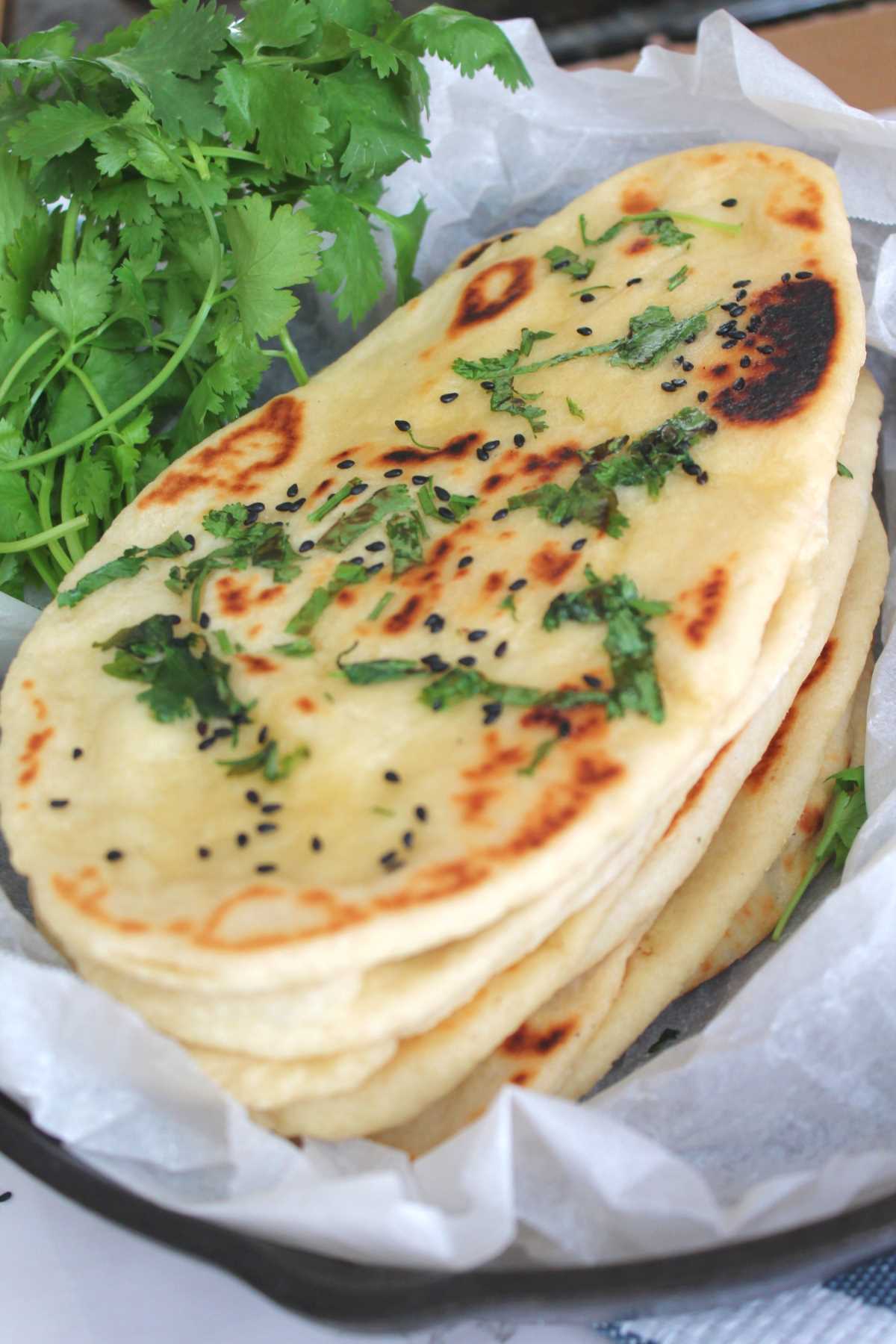
Tips About Naan Bread Dough
In this section, I have tried to answer all the questions I get about the dough for the Naan Bread recipe. Hope you find all the tips helpful!
How To Measure The Flour The Right Way
The taste and texture of naan bread may vary, depending upon the quantity of flour used. It is important to measure the flour using the right method.
To avoid over-measuring, do not scoop the flour straight from the container. First, loosen the flour by giving it a good stir with a spoon or a spatula.
Next, spoon the flour into the measuring cup, and fill the cup slightly over the rim. Now, level the flour using the back of the spoon or a knife.
Consistency Of The Dough
The consistency of the dough may vary, as we are measuring the ingredients using a cup(volume), instead of weighing them. Also, it depends on the protein content of the flour used.
What you are looking for is a soft, elastic, non-sticky dough. When you poke the dough, it springs back and does not stick.
Check the consistency of the dough after kneading it for 4-5 minutes (stand mixer). If it feels too sticky, add some flour and knead it again, until the dough starts to leave the sides of the bowl.
If the dough is too dry, add 1-2 teaspoons of warm milk, and knead the dough, until it is nice and soft.
How Long Do You Knead The Dough
Depending upon the method used for kneading, the time will vary. If you are using a stand mixer to knead the dough, it takes somewhere from 8-10 minutes to knead the dough. If kneading the dough by hand, it takes around 20-25 minutes for a soft, non-sticky dough.
How Do I Know If The Dough Is Kneaded Well
A well-kneaded dough will be soft, elastic, springs back when you poke your finger, and won’t be sticky. If the dough does not pass this simple test, it means it needs more kneading. Here are a few ways you can tell that the dough is kneaded well:
First, it forms into a nice smooth dough, the dough will start to leave the sides of the bowl.
Secondly, poke a finger, and if the dough springs back, and is not sticky, the dough is kneaded well.
Lastly, you can also do a windowpane test. Take a small piece of dough, and stretch it as thin as possible. If the dough does not tear, and you can see a thin layer of dough, it means the dough is kneaded well.
Why Do You Knead The Dough
It is important to knead the dough before rising, as kneading develops the gluten in the dough. Gluten is made of long strands of protein, which makes the dough stretchy. The stretchy dough can hold the bubbles created by the yeast, thus making the dough rise.
Why Is My Dough To Sticky
Too much liquid can cause a sticky dough. Also, if you used cold, or room temperature milk, it can result in leaking of glutens, causing the dough to be sticky.
Why Is My Dough Too Tight
When using a stand mixer chances are that you overworked the dough. The change in the composition of gluten molecules results in a non-stretchy dough. Overworked dough often feels too tight, and tough and breaks when you try to pull, or roll.
Why Naan Is Dense & Chewy
For nice, soft, and fluffy Naan Bread recipe, it is important to knead the dough enough. When the dough is not kneaded enough, either using a stand mixer or by hand, the dough will lack strength. When you make naan using this dough, chances are it will turn out chewy and quite dense in texture.
As the yeast grows, it produces gas and carbon dioxide. Depending upon how much gas is produced in the dough, the naan will turn out light and soft.

Storage
At Room Temperature: Once the naan is cooled completely, place them in a Ziploc bag, or a air-tight container. Naan lasts for 2-3 days at room temperature.
Refrigerate: Naan can be stored in the refrigerator for up to a week. Reheat the naan in a microwave for 10 seconds, before serving.
Freezer: Naan freezes beautifully. Store them in freezer-friendly storage bags or containers, and they will last for a couple of months. Defrost, reheat, and enjoy moist, and soft homemade Naan.
Reheat: Reheat the naan in the microwave for 10 seconds, or on a griddle for 1-2 minutes. Apply some butter or oil before reheating.
Tips
Here are some tips to help you make a delicious easy Naan Recipe:
1. Rest the Dough Properly: Allowing the dough to rest and rise adequately is crucial for soft and fluffy naan. Give the yeast enough time to work its magic, and the dough to double in size. This typically takes around 1 to 1.5 hours in a warm, draft-free place.
2. Use a Hot Oven or Griddle: Preheat your oven to the highest temperature possible before baking the naan. A hot oven mimics the intense heat of a tandoor, helping the naan cook quickly and achieve the characteristic puffed-up appearance. Make sure the griddle or Tawa is hot before cooking the naan.
3. Roll the Dough Uniformly: Roll out the naan dough evenly to ensure even cooking and a consistent texture. Avoid rolling the dough too thin or too thick. Aim for a thickness of about ¼-inch (approximately 6 mm).
4. Add Flavors and Fillings Sparingly: When using flavored toppings or fillings, be cautious not to overload the naan, as excessive toppings can interfere with the even cooking and rising of the bread.
5. Brush with Butter or Ghee: For added richness and flavor, brush the hot naan with melted butter or ghee right after taking it out of the oven or tawa. This step enhances the taste and keeps the bread moist.
6. Monitor Baking Time: Keep an eye on the naan while it's baking to avoid overcooking. Naan cooks quickly, usually within 2-3 minutes in a hot oven.
7. Use a Pizza Stone or Baking Steel: If you're baking naan in an oven, place a pizza stone or baking steel on the top rack. Preheating the stone or steel helps simulate the intense heat of a tandoor and gives the naan a crispier bottom.
8. Keep Naan Warm: To keep Naan warm and soft after baking, wrap it in a clean kitchen towel or aluminum foil. This will help retain the heat and moisture, ensuring a delightful texture when served.
9. Enjoy Freshly Made Naan: Naan is best enjoyed fresh and warm. Serve it immediately for the best taste and texture.
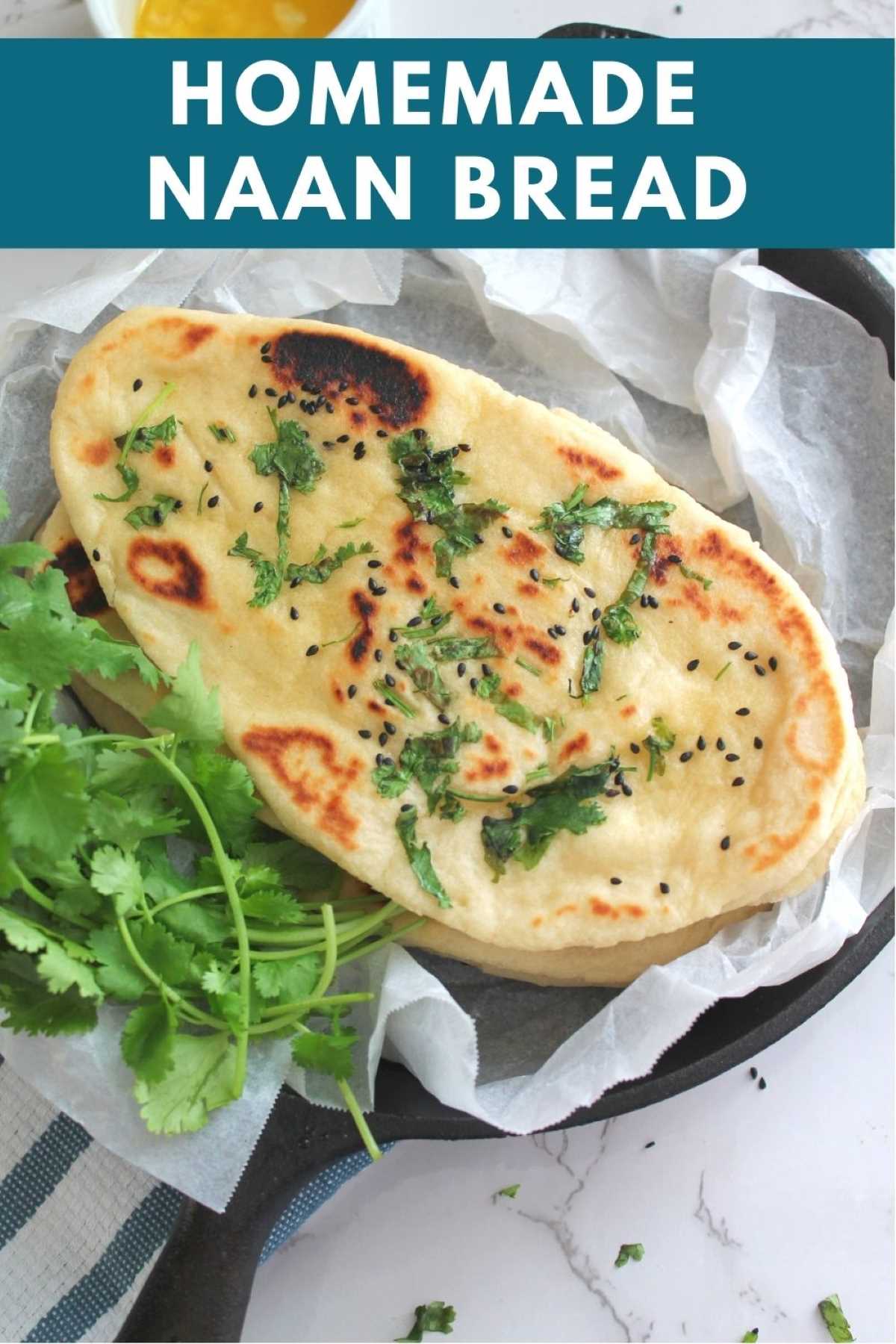
FAQ
Generally, whole wheat bread is considered healthier than traditional naan due to its higher fiber content and lower fat content. However, both can be part of a balanced diet when enjoyed in moderation and paired with nutritious accompaniments.
Naan is made with all-purpose flour, water, yeast, yogurt, sugar, ghee or oil, and salt. It can also include optional ingredients such as garlic, cheese, herbs, and various fillings for flavored or stuffed variations.
Naan dough is made from a mixture of all-purpose flour (maida), water, yeast, plain yogurt, sugar, ghee or oil, and salt. These ingredients are combined to create a soft, elastic dough that is allowed to rise before being shaped and cooked in a tandoor oven or griddle.
Naan and pita are both types of flatbreads, but they have some differences. Naan is typically made with all-purpose flour, leavened with yeast, and often includes yogurt and ghee, resulting in a softer, thicker bread. Pita, on the other hand, is made with a combination of all-purpose flour and whole wheat flour, leavened with yeast, and does not typically contain yogurt or ghee, resulting in a thinner, pocketed bread.
Serving

The Best Naan Bread Recipe
Equipment
Ingredients
INGREDIENTS FOR NAAN BREAD
- 2 ½ cups all purpose flour
- ¾ cup warm milk, [100*F – 110* F]
- 1 tablespoon Active Dry Yeast
- 1 tablespoon sugar
- 2 tablespoon plain yogurt, room temperature
- ½ teaspoon salt
- 2 tablespoon unsalted butter, softened
- 1-2 tablespoon lukewarm milk, optional
- 1 tablespoon vegetable or canola oil, to grease the pot
FOR NAAN TOPPING
- 2 tablespoon butter, unsalted or Ghee
- 1 teaspoon Nigella seeds (kalonji)
- 1 tablespoon fresh garlic, chopped
- Handful of fresh cilantro, chopped
Instructions
Step 1: Activate Yeast
- In a cup, stir in ¾ cup of warm milk [100*F – 110* F], sugar, and yeast. Let the mixture stand for 10 minutes, or until it turns frothy, and doubles in volume.Note: If the yeast is active, the mixture turns frothy, and doubles in volume. If the mixture does not double in size, start the process again with fresh yeast.
Step 2: Prepare Dough
- In the bowl, add flour, salt, yogurt, and yeast mixture. Mix all the ingredients until the flour is incorporated and forms a dough.
- Remove the dough on a clean surface, and add softened butter. Knead the dough until it is soft, elastic, springs back when pressed, and is not sticky for around 20-25 minutes.
- Alternatively, you can use a Stand Mixer to knead the dough.Attach the dough hook attachment to the stand mixer. In the bowl of a stand mixer, add flour, salt, yogurt, and yeast mixture. Beat the mixture on a low speed for 2-3 minutes, or until the flour is incorporated. Scrape the bowl occasionally.
- Add softened butter. Increase the speed to medium-high, and knead the dough for 4-5 minutes, or until it forms into a smooth dough ball, and starts to leave the sides of the bowl.
- Transfer the dough, onto a lightly greased work surface, and shape it into a ball.
Step 3: First Proofing
- Place the dough in a greased bowl and turn it once to grease the top.
- Cover the bowl with a kitchen towel, and place it in a warm place, or an oven with the oven light on for 1-2 hours or until it doubles in volume.Note: Keep the oven turned OFF.
- Alternatively, use Instant Pot to proof the dough.Place the dough in the greased inner pot, and turn it once to grease the top.
- Place the lid, and cover the pot. Turn ON YOGURT (normal) for 1 hour.Note: Use a glass lid that fits, to cover the inner pot.
Step 4: Divide The Dough
- Transfer the dough onto a work surface, and punch it down. Divide the dough into 8 equal pieces. Cover the pieces with a clean kitchen towel, while you work with a single piece.
- Take a piece of the dough ball, gather all the edges, and tuck them in the center. Turn the dough, seam side down, and roll it into a smooth ball.Note: If required, sprinkle some flour on the work surface.
- Place the rolled dough ball, seam side down, onto a baking sheet. Cover with a clean kitchen towel while you roll the rest of the balls.
Step 5: Second Proofing
- Cover the baking sheet with a kitchen towel, and place it in a warm place or an oven with the oven light ON for 10 minutes, or until the rolls have doubled in size.
Step 6: Shape The Naan Bread
- Place the dough ball on a rolling surface, and roll it into an oval shape, around 7-8 inches long and 3-4 inches wide. FOR GARLIC BUTTER NAAN / NIGELLA SEEDS TOPPING - please refer below.
- Place the rolled naan bread onto a baking sheet, and cover it with a clean kitchen towel. Repeat the process with the remaining dough.
Optional Toppings: Garlic Butter Naan | Seeds Toppings
- For Garlic Butter Naan: Apply some melted butter, sprinkle some chopped garlic, and fresh cilantro. Press it gently with the rolling pin and cook the naan.
- For Nigella Seeds Naan: Sprinkle some nigella seeds and fresh cilantro. Press it gently with the rolling pin and cook the naan.
Step 7: Cook The Naan Bread
- Heat the Tawa (Griddle). Start with the first rolled naan, then the second rolled naan, and so on.
- Apply some water to the bottom side of the naan and place the bottom side down on the Tawa. Cook naan over medium-low heat until lightly browned, around 2-3 minutes.
- Carefully turn it upside down and cook on the other side. Gently press the naan with a spatula for even cooking.Note: You can directly cook naan over the flame.
- Apply some butter or Ghee on top, and enjoy warm, fluffy, naan bread!!
- Alternatively, Bake Naan: Preheat the oven to 450 F (the highest temperature possible), with a pizza stone or an upside-down baking sheet inside to simulate the tandoor's cooking environment.
- Carefully transfer the rolled-out naan onto the preheated pizza stone. Bake for about 2-3 minutes until the naan puffs up and develops a golden-brown color.Note: Every oven is different, please watch the baking time.
Video
Notes
- Pro Tips For The Best Naan Bread
- Frequently Asked Questions
Nutrition
Disclaimer
Nutrition values are my best estimates. If you rely on them for your diet, use your preferred nutrition calculator.

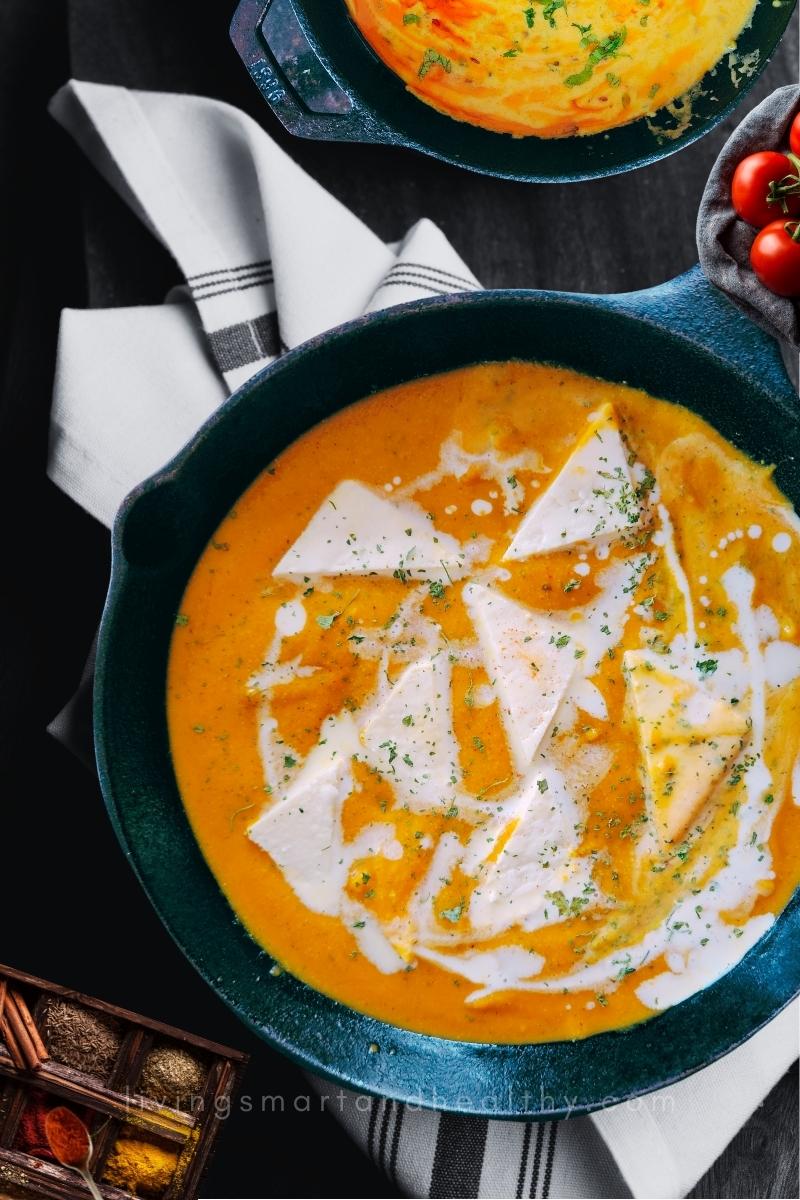
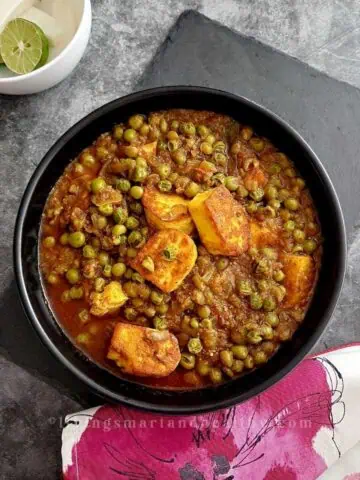
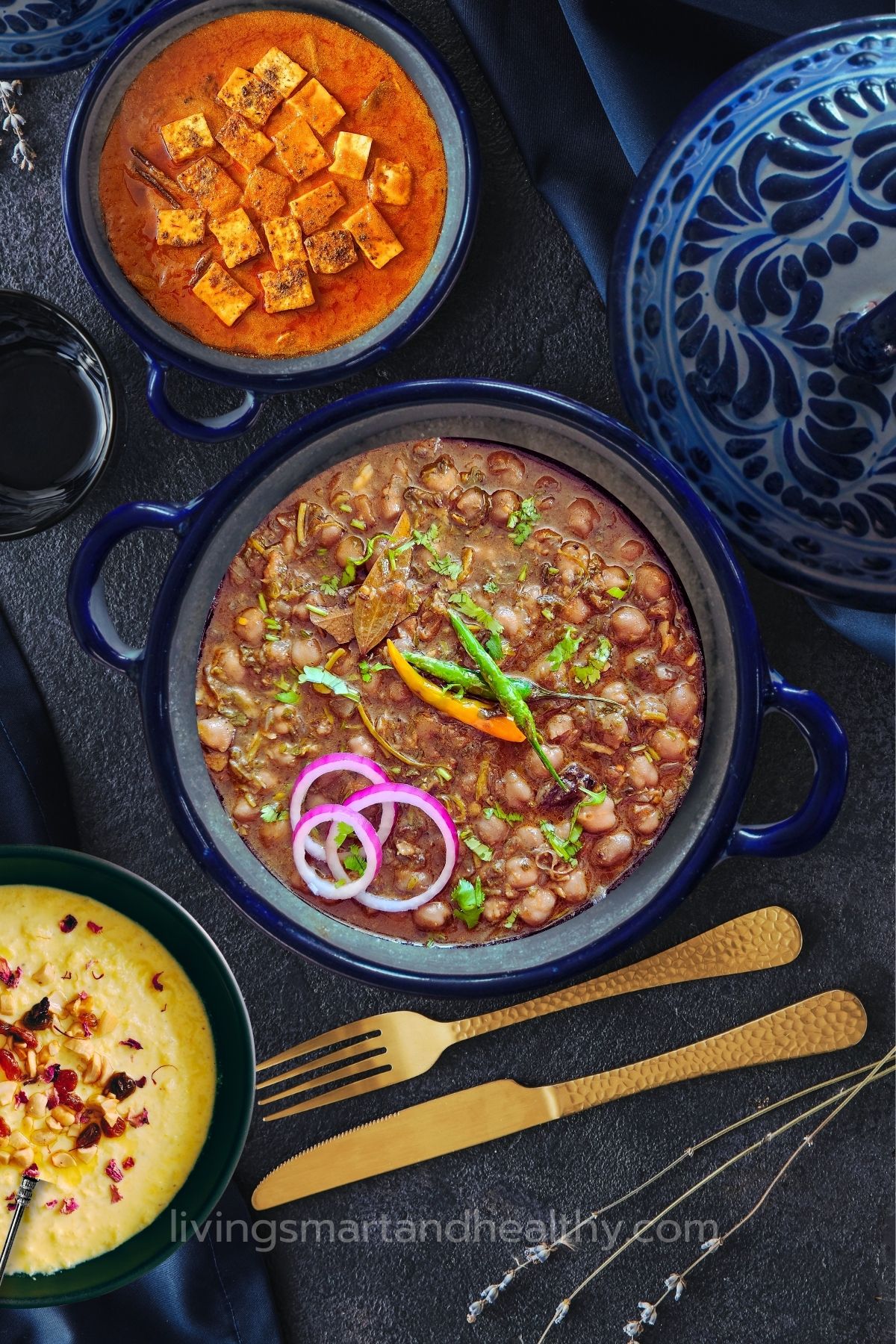
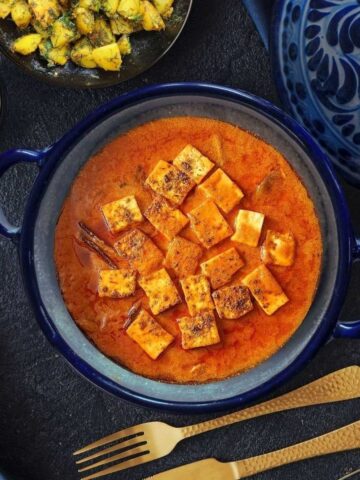
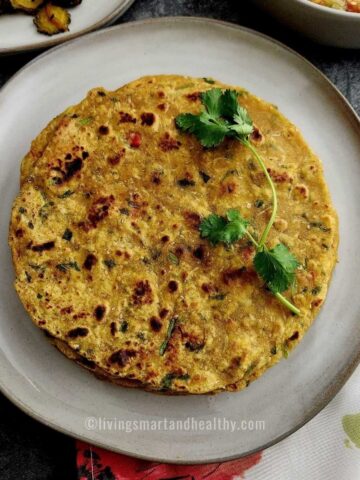
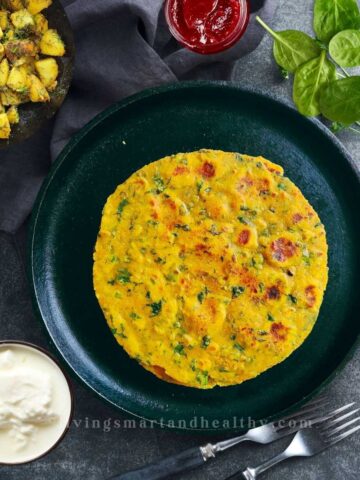
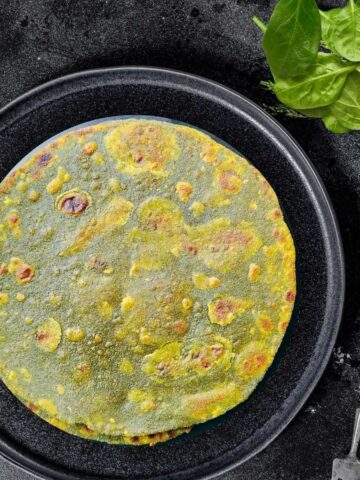
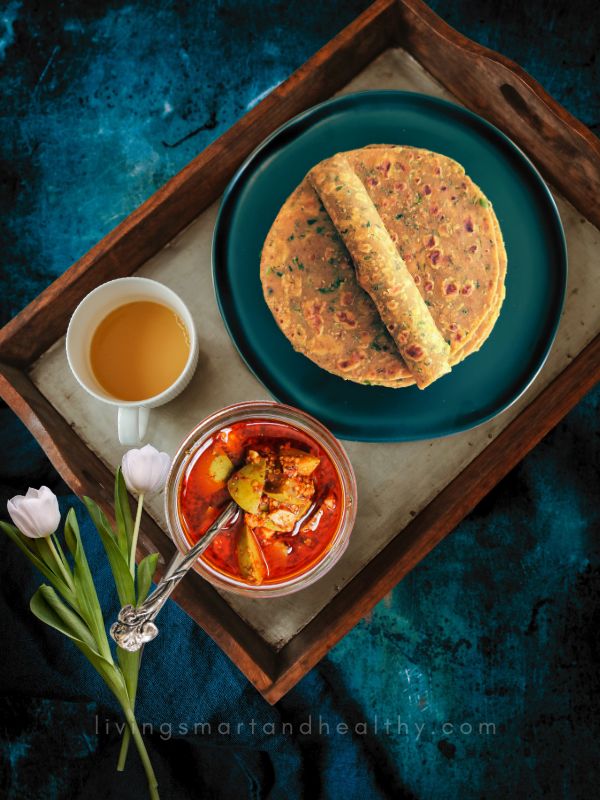
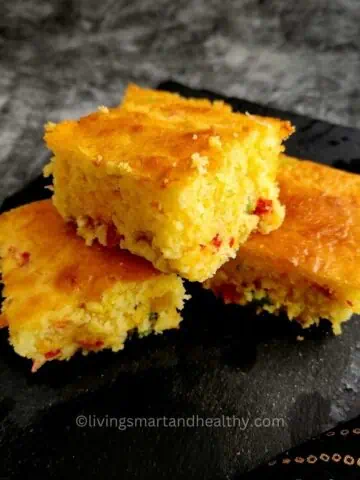
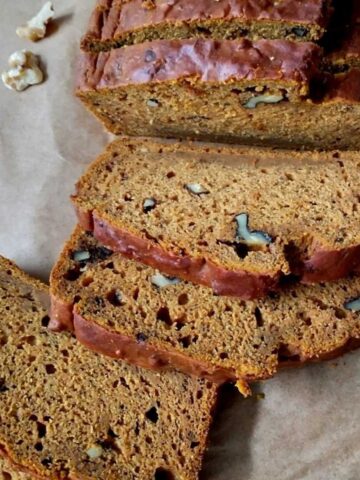
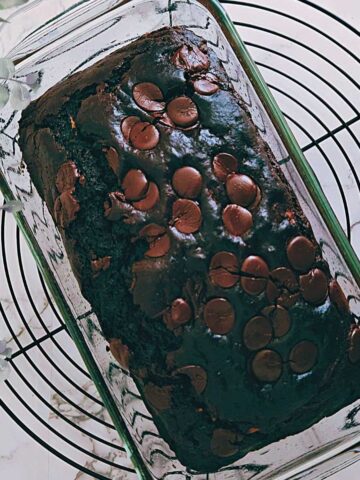
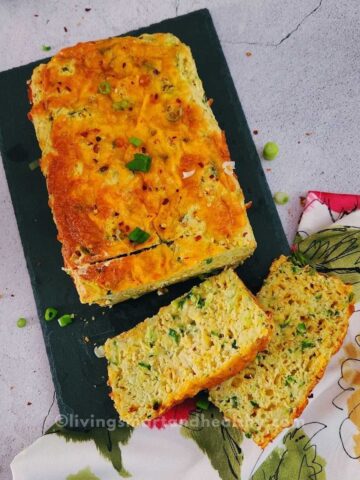
Sara says
Hi, My family loves Indian food. And this was my first time making naan bread. I followed your recipe and the naan turned out amazing! I am so pleased that I could make naan at home with ease. Thanks for this easy recipe!!
Jyoti Behrani says
My pleasure ? I am so glad to hear that!